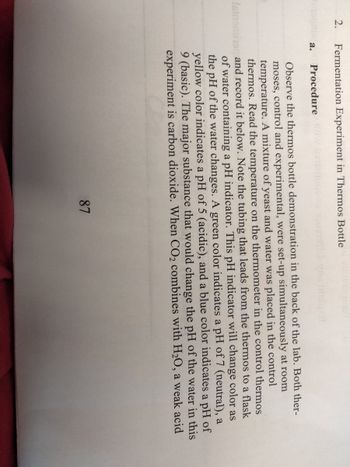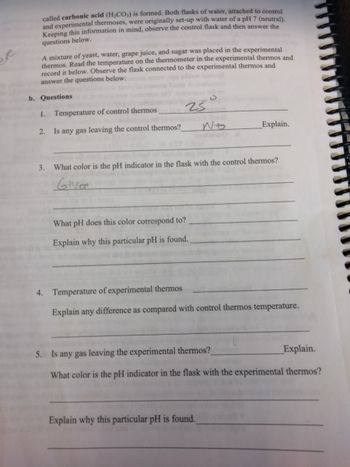
Human Anatomy & Physiology (11th Edition)
11th Edition
ISBN: 9780134580999
Author: Elaine N. Marieb, Katja N. Hoehn
Publisher: PEARSON
expand_more
expand_more
format_list_bulleted
Question

Transcribed Image Text:2.
Fermentation Experiment in Thermos Bottle
a.
Procedure
Observe the thermos bottle demonstration in the back of the lab. Both ther-
moses, control and experimental, were set-up simultaneously at room
temperature. A mixture of yeast and water was placed in the control
thermos. Read the temperature on the thermometer in the control thermos
Istomins and record it below. Note the tubing that leads from the thermos to a flask
of water containing a pH indicator. This pH indicator will change color as
the pH of the water changes. A green color indicates a pH of 7 (neutral), a
yellow color indicates a pH of 5 (acidic), and a blue color indicates a pH of
9 (basic). The major substance that would change the pH of the water in this
experiment is carbon dioxide. When CO₂ combines with H₂O, a weak acid
87

Transcribed Image Text:eve
called carbonic acid (H₂CO3) is formed. Both flasks of water, attached to control
and experimental thermoses, were originally set-up with water of a pH 7 (neutral).
Keeping this information in mind, observe the control flask and then answer the
questions below.
A mixture of yeast, water, grape juice, and sugar was placed in the experimental
thermos. Read the temperature on the thermometer in the experimental thermos and
record it below. Observe the flask connected to the experimental thermos and
answer the questions below.
b. Questions
1. Temperature of control thermos
2.
3.
Is any gas leaving the control thermos?
25
What pH does this color correspond to?
Explain why this particular pH is found.
No
What color is the pH indicator in the flask with the control thermos?
Giver
Explain.
4. Temperature of experimental thermos
Explain any difference as compared with control thermos temperature.
Explain why this particular pH is found.
5. Is any gas leaving the experimental thermos?
Explain.
What color is the pH indicator in the flask with the experimental thermos?
Expert Solution
This question has been solved!
Explore an expertly crafted, step-by-step solution for a thorough understanding of key concepts.
Step by stepSolved in 3 steps

Knowledge Booster
Learn more about
Need a deep-dive on the concept behind this application? Look no further. Learn more about this topic, biology and related others by exploring similar questions and additional content below.Similar questions
- Please step by step answer please current answerarrow_forwardDo explain Question:- A common and effective treatment for arsenite poisoning involves administration of _____. aresenite chelator vitamin B1 a competitive sulfhydryl reagent NADPH a dihydrolipoyl inhibitorarrow_forwardPlease answer both Note :- Other wise down vote.arrow_forward
- The hydrolysis of a substrate, S, by an enzyme has been studied in the lab. The following initial rates, vo, were recorded at different concentrations. [S] (M) Vo (M/min) 2.10-10-4 1.20.10-6 4.20-10-4 3.10.10-6 9.30-10-4 6.30-10-6 1.42-10-3 9.10-10-6 A. Determine the rate constants for degradation of the substrate B. What is the rate of reaction at [S] = 1.1.104 M? C. Explain, why enzymes can make reactions go faster? Does enzymes also catalyse the reverse reaction from product to substrate?arrow_forwardWhat is the concentration of LDH at DF 10arrow_forwardThe ideal temperature for all enzymes is 98.6 degrees F False Truearrow_forward
- 0 1 3 4. 9. 8. 6. 10 pH The optional pH for enzyme 1 is: Select one: a. 5. O b. 4. O c. 3. O d. 2. 5. 2. 123arrow_forwardshow all steps and answerarrow_forward21. _____________________________________ adds acyl groups to two carbons of the backbone of developing triacylglycerols. 22. When will AMPK be active? 23. ______________________________________ phosphorylates glycerol making glycerol 3-phosphate. 24. How long after exercise commences does lipolysis reach its maximal rate? 25. What is the role of elongases? Why are they necessary? 26. Why is there the potential for such great variety among triglycerides? 27. Explain why triacylglycerols are called triacylglycerols. Basically, tell me how this name describes their structure.arrow_forward
arrow_back_ios
arrow_forward_ios
Recommended textbooks for you
 Human Anatomy & Physiology (11th Edition)BiologyISBN:9780134580999Author:Elaine N. Marieb, Katja N. HoehnPublisher:PEARSON
Human Anatomy & Physiology (11th Edition)BiologyISBN:9780134580999Author:Elaine N. Marieb, Katja N. HoehnPublisher:PEARSON Biology 2eBiologyISBN:9781947172517Author:Matthew Douglas, Jung Choi, Mary Ann ClarkPublisher:OpenStax
Biology 2eBiologyISBN:9781947172517Author:Matthew Douglas, Jung Choi, Mary Ann ClarkPublisher:OpenStax Anatomy & PhysiologyBiologyISBN:9781259398629Author:McKinley, Michael P., O'loughlin, Valerie Dean, Bidle, Theresa StouterPublisher:Mcgraw Hill Education,
Anatomy & PhysiologyBiologyISBN:9781259398629Author:McKinley, Michael P., O'loughlin, Valerie Dean, Bidle, Theresa StouterPublisher:Mcgraw Hill Education, Molecular Biology of the Cell (Sixth Edition)BiologyISBN:9780815344322Author:Bruce Alberts, Alexander D. Johnson, Julian Lewis, David Morgan, Martin Raff, Keith Roberts, Peter WalterPublisher:W. W. Norton & Company
Molecular Biology of the Cell (Sixth Edition)BiologyISBN:9780815344322Author:Bruce Alberts, Alexander D. Johnson, Julian Lewis, David Morgan, Martin Raff, Keith Roberts, Peter WalterPublisher:W. W. Norton & Company Laboratory Manual For Human Anatomy & PhysiologyBiologyISBN:9781260159363Author:Martin, Terry R., Prentice-craver, CynthiaPublisher:McGraw-Hill Publishing Co.
Laboratory Manual For Human Anatomy & PhysiologyBiologyISBN:9781260159363Author:Martin, Terry R., Prentice-craver, CynthiaPublisher:McGraw-Hill Publishing Co. Inquiry Into Life (16th Edition)BiologyISBN:9781260231700Author:Sylvia S. Mader, Michael WindelspechtPublisher:McGraw Hill Education
Inquiry Into Life (16th Edition)BiologyISBN:9781260231700Author:Sylvia S. Mader, Michael WindelspechtPublisher:McGraw Hill Education

Human Anatomy & Physiology (11th Edition)
Biology
ISBN:9780134580999
Author:Elaine N. Marieb, Katja N. Hoehn
Publisher:PEARSON

Biology 2e
Biology
ISBN:9781947172517
Author:Matthew Douglas, Jung Choi, Mary Ann Clark
Publisher:OpenStax

Anatomy & Physiology
Biology
ISBN:9781259398629
Author:McKinley, Michael P., O'loughlin, Valerie Dean, Bidle, Theresa Stouter
Publisher:Mcgraw Hill Education,

Molecular Biology of the Cell (Sixth Edition)
Biology
ISBN:9780815344322
Author:Bruce Alberts, Alexander D. Johnson, Julian Lewis, David Morgan, Martin Raff, Keith Roberts, Peter Walter
Publisher:W. W. Norton & Company

Laboratory Manual For Human Anatomy & Physiology
Biology
ISBN:9781260159363
Author:Martin, Terry R., Prentice-craver, Cynthia
Publisher:McGraw-Hill Publishing Co.

Inquiry Into Life (16th Edition)
Biology
ISBN:9781260231700
Author:Sylvia S. Mader, Michael Windelspecht
Publisher:McGraw Hill Education